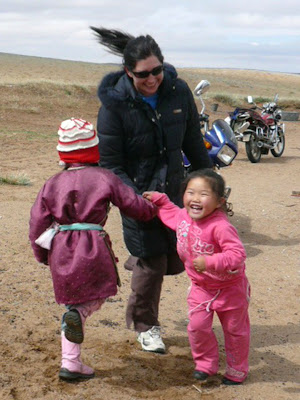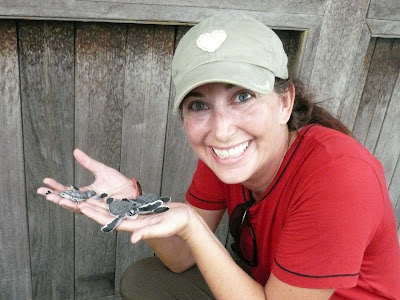Lisa Niver Rajna is our Geography Awareness Editor, a world traveler, and a science teacher in Los Angeles, California. Think that science isn't international? Think again! I'm impressed with the work that Lisa does with her students - exploring the world, and the people in it. She's the publisher of two websites that combine her love of travel and teaching science - We Said Go Travel, and Science Isn't Scary. She embodies the true meaning of international education - and practices it every day.

We caught up with Lisa and asked her about how schools can include international education in the curriculum, infusing global awareness in her students, and more. Here's what she had to say...
WE: Please tell us about your work in International Education...
LNR: I am an enthusiastic world traveler. I want to travel everywhere and share what I learn about places with others. I currently teach students from Kindergarten through-6th grade science in a private elementary school and blog online about my travels at WeSaidGoTravel.net, and blog about science and global education at ScienceIsntScary.net. I share my adventures with students to inspire them about our global community. I see connections and feel compelled to help students be excited about science, geography, culture and themselves.
Lisa Niver Rajna in Samoa
WE: What led you to wanting to include international education into the curriculum?
LNR: In science class, we do fun experiments like making snow, creating soda, and exploding volcanoes and rockets. But we also learn about issues like the Congo Conflict Free Minerals Act. We have written to President Obama about what we learned. For the issues of water and the people of Tuvalu, my 4th graders recently were the first students in the USA to watch the documentary "Trouble in Paradise" and afterwards we met with the director to ask questions and learn more. He encouraged us to write to politicians and we did. My 6th graders are the first students in the United States to participate in the 20th year of the OXFAM-Canada international recycled toy contest and they loved this project which we did in art and science classes. One of my students even won an award.
My students love to hear about my adventures. When we talk about measurement, I show photos of the floating market in Kalimantan, Indonesia; when we talk about nomads, I show them the gers of Mongolia. I have included more and more of my travel stories in my classes as the kids love to learn about real places and people. The students are making incredible connections and so intrigued by the photos and stories.
We often talk about WHY are we learning this and WHY we should care. Whether talking about plate tectonics or the recent earthquakes and tsunamis we discuss how they impact their victims and our planet.

floating market in Kalimantan, Indonesia
WE: How do you feel that schools can best promote international education?
LNR: For schools to reach their students, I think we need to connect with what is real. Students want to learn and to be connected. They want to use technology and do meaningful work. I think by sharing real stories and focusing on current issues schools will have more interested students who are better global citizens.
For our Genetics Unit in 6th grade, I shared a series of articles on Genetically-Modified Food. We are going to be interviewed by a reporter about our feelings regarding these issues. This real-world problem is important and will now combine their interest with science and language arts and real life!

WE: How can international educators - and parents - promote intercultural and diversity issues?
LNR: I believe we all need to make a commitment to connecting classroom teaching with global issues. I know my best lessons, the ones I think are great and so do students, usually involve something real. When we called author Simon Basher in London via Skype, my 1st grade students asked him where his book ideas come from, how did he get his books published, what kind of science did he study. They had fascinating questions and were inspired by him. We made a book in his style about the water cycle (our unit of study.) This year we are going to call Stacey Zolt Hara of Travel with Bella in Singapore. Just figuring out the time change between California and Singapore focuses issues of understanding and diversity.

WE: How can k-12 educators infuse global awareness and teaching about the world into their classrooms?
LNR: Infusing global awareness into classrooms really is just good teaching. Students need to be shown the way the subjects interrelate. I work hard to integrate my lessons with real life examples, and with other subjects. The art teacher and librarian at my school are part of my science team. For our biomes study in 3rd grade, the students study Steve Jenkins books in the library. They research an animal in Science class, using print and Internet sources and create their animal in art using collages, also in the style of Steve Jenkins. These incredible pieces are treasures as the students have learned so much through their research. I scan all the animals at the end of the project and make an eBook so everyone in the class has all the research and animals from the entire grade.
Biomes or ecosystems are local and global. Some biomes are on every continent, when we study them we look at world maps and talk about how the planet is changing. It is an opportunity to talk about climate change and other topics of global interest.

WE: What is up next for you?
LNR: I am working on integrating my teaching and my traveling more and more. Next I would like to connect with other teachers and parents who think teaching global awareness is crucial. I will keep sharing and writing and see where that takes me next. I know my students are so interested in science and global issues and I would like everyone to be that excited about our planet!

WE: Is there anything else you'd like to share with us?
LNR: I would love to hear from other wanderers, teachers, parents and nomads about teaching tools and great books that highlight other cultures. I think we need to place some focus on helping children love learning and being inspired to read, write and to create meaning.
WE: Thanks so much, Lisa! I think your students are VERY lucky to have you!
All photos courtesy and copyright Lisa Niver Rajna
